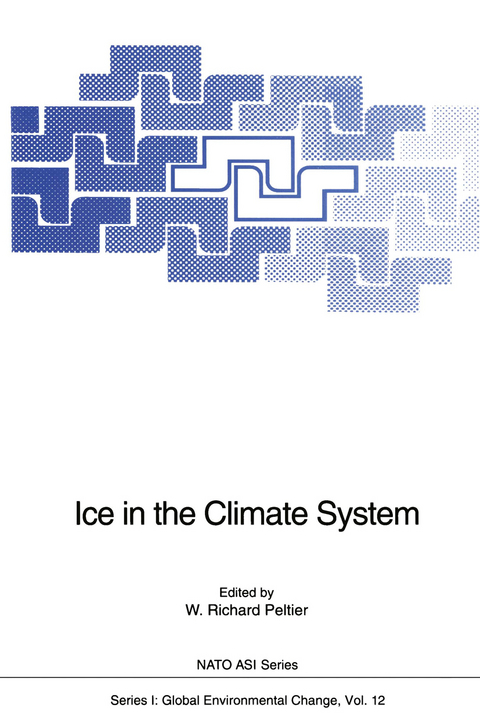
Ice in the Climate System
Springer Berlin (Verlag)
978-3-642-85018-9 (ISBN)
According to my latest model for the last glacial maximum (LGM) (Grosswald 1988), the Arctic continental margin of Eurasia was glaciated by the Eurasian ice sheet, which consisted of three interconnected ice domes --the Scandinavian, Kara, and East Siberian. The Kara Sea glacier was largely a marine ice dome grounded on the sea's continental shelf. The ice dome discharged its ice in all directions, northward into the deep Arctic Basin, southward and westward onto the mainland of west-central North Siberia, the northern Russian Plain, and over the Barents shelf into the Norwegian-Greenland Sea On the Barents shelf, the Kara ice dome merged with the Scandinavian ice dome. In the Arctic Basin the discharged ice floated and eventually coalesced with the floating glacier ice of the North-American provenance giving rise to the Central-Arctic ice shelf. Along its southern margin, the Kara ice dome impounded the northward flowing rivers, causing the formation of large proglaciallakes and their integration into a transcontinental meltwater drainage system. Despite the constant increase in corroborating evidence, the concept of a Kara ice dome is still considered debatable, and the ice dome itself problematic. As a result, a paleogeographic uncertainty takes place, which is aggravated by the fact that a great deal of existing knowledge, no matter how broadly accepted, is based on ambiguous interpretations of the data, most of which are published in Russian and, therefore, not easily available to western scientists.
I- Ice Sheet Modelling.- Extent and melting history of the late Weichselian ice sheet, the Barents-Kara continental margin.- Modelling of the Fennoscandian ice sheet.- Controls on changes in the West Antartic ice sheet.- Plastic modelling of glaciers and outlets.- Qualitative dynamics of marine ice sheets.- II- Ice Sheet Mass Balance.- Modelling of glacier mass balance.- Observations and simulations of temperature and ice accumulation at the surface of Antarctica.- World sea level and the present mass balance of the Antarctic ice sheet.- Ice, climate, and sea level; do we know what is happening?.- III- Ice Sheet-Ocean-Atmosphere Interactions.- Heinrich events: triggers of ocean circulation change?.- Heinrich events: chronology and processes, east-central Laurentide ice sheet and NW Labrador Sea.- Transport of freshwater into the deep ocean by the conveyor.- The driving force of brine rejection on the deepwater formation in the Hamburg LSG OGCM.- The melting of continental ice in the ocean and its impact on surface and bottom waters.- Hydrological cycle scenarios, deep ocean circulation, and century/millennium climate change: a simulation study using an ocean-atmosphere-ice sheet model.- A simple systems model of the major glaciation cycles.- Climate model studies of interactions between ice sheets and the atmosphere-ocean system.- Modelling ice sheet and climate changes through the ice ages.- Simulation of the climate of the last 200 kyr with the LLN 2D-model.- The late Cenozoic glacial regimes as a combined response to earth-orbital variations and forced and free CO2 variations.- IV- The Thermohaline Circulation.- The delicacy of the oceanic thermohaline circulation.- Multiple equilibria in ?-plane thermohaline convection.- Younger Dryas Experiments.- Deep decouplingoscillations of the oceanic thermohaline circulation.- The glacial ocean: a study with a zonally averaged, three-basin ocean circulation model.- Oscillatory modes of behavior in a simple model of the Atlantic thermohaline circulation.- Correlation of Greenland ice-core and ice-margin ?(18O) records.- V- Climate Data from Ice Cores.- The connection between ice dynamics and paleoclimate from ice cores: a study of Taylor Dome, Antarctica.- Past accumulation rates derived from observed annual layers in the GRIP ice core from Summit, Central Greenland.- VI- Sea Ice Effects on Climate System Evolution.- Sea ice: a factor in influencing climate on short and long time scales.- Nonlinear paleoclimatic variability from quaternary records.- The Arctic responce to CO2-induced warming in a coupled atmosphere-ocean general circulation model.- Ocean heat and seasonal sea ice thickness in the southern ocean.- Quantitative Reconstruction of Sea-Surface Conditions, Seasonal Extent of Sea-Ice Cover and Meltwater Discharges in High Latitude Marine Environments from Dinoflagellate Cyst Assemblages.- North Atlantic sea surface salinity, ice melting and abrupt climatic changes.- Interannual and climatic characteristics of an ice ocean circulation model.- A thermodynamic-dynamic snow sea-ice model.
| Erscheint lt. Verlag | 25.1.2012 |
|---|---|
| Reihe/Serie | Nato ASI Subseries I: |
| Zusatzinfo | XIV, 673 p. |
| Verlagsort | Berlin |
| Sprache | englisch |
| Maße | 155 x 235 mm |
| Gewicht | 1030 g |
| Themenwelt | Naturwissenschaften ► Biologie ► Ökologie / Naturschutz |
| Naturwissenschaften ► Geowissenschaften ► Geologie | |
| Naturwissenschaften ► Geowissenschaften ► Geophysik | |
| Naturwissenschaften ► Geowissenschaften ► Meteorologie / Klimatologie | |
| Schlagworte | air pollution and air quality • Atmosphere • Carbon dioxide • Climate • climate change • Eis • Environment • ICE • Klima • ocean • Oceanography • Orbit • Ozeanographie • Paläoozenographie • paleoclimate • Paleo-oceanography • scale • Snow • Temperature • Tide • Transport |
| ISBN-10 | 3-642-85018-9 / 3642850189 |
| ISBN-13 | 978-3-642-85018-9 / 9783642850189 |
| Zustand | Neuware |
| Haben Sie eine Frage zum Produkt? |
aus dem Bereich


